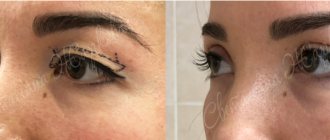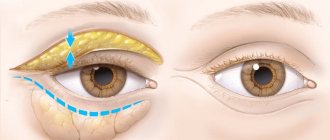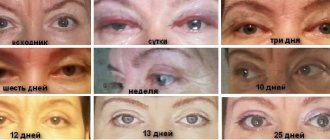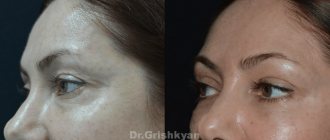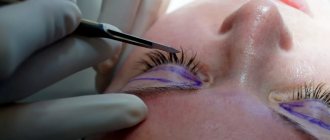Recently, blepharoplasty of Asian eyelids has been gaining popularity - an operation to Europeanize the eyes among people of the Eastern type. This operation allows you to correct the features of the Mongoloid eyelids, making the look more open and expressive. Sometimes this operation is also called “Singapuri”.
I have extensive experience in performing Asian eyelid surgery, I have my own proprietary technique, and my patients are very pleased with their appearance after surgery. I invite you to read the results of the operations, reviews of blepharoplasty for Asian eyelids and learn more about the operation itself.
The patient underwent surgery to Europeanize her Asian eyelids. This result is presented 1.5 months after surgery.
Photos before and after blepharoplasty of Asian eyelids
The following photos illustrate the incredible transformation of one of my patients, not only externally, but also internally. After surgery for Asian eyelid surgery, the girl became more open, sociable and self-confident. So:
Photos before and 2 months after Asian eyelid surgery
Below is the result of Europeanization of the Asian eyelids of the same girl after 8 months
The work of plastic surgeon S. N. Zharkova, Moscow
Look how noticeably the girl’s appearance has changed thanks to the operation of Europeanization of the Asian century.
See more photos of the results of operations to Europeanize Asian eyelids here
Forecast
When choosing a good plastic surgeon, patients are usually satisfied with their appearance.
Complications rarely occur:
- swelling;
- cyanosis;
- tearfulness;
- infection, conjunctivitis;
- noticeable scars, for example, if the incision is made far from the natural fold.
It is worth noting that these complications are not always the result of surgeon errors when planning and performing the operation. Any surgical intervention is an injury to which the body can react in different ways. At the same time, an experienced specialist knows not only how to avoid these mistakes, but also how to help the patient recover faster.
The result of the technique lasts 10–12 years, depending on the patient’s genetics and lifestyle.
(2 ratings)
Types of Asian Eyelid Blepharoplasty
- Correction of the upper eyelids. The formation of upper orbital folds is expected, excess fatty tissue in the upper eyelid is removed, and Z-eplasty of the epicanthus is performed. The look becomes more open, and the bridge of the nose narrows.
- Correction of the lower eyelids. Excess dermis and fatty tissue are removed. This stage is not performed in every patient with Asian eyelids. Since most patients undergoing this type of surgery are young people, there are no indications for surgery in the lower eyelid area yet.
- Mixed plastic. The shape of the upper and lower eyelids is corrected. Appearance changes significantly towards the Caucasian type.
In most cases, during plastic surgery of Asian eyes, only the first point is performed, i.e. upper eyelid blepharoplasty.
If there are indications for blepharoplasty in the lower eyelid area, then such an operation can be performed using an open or closed method. Open plastic surgery involves an incision along the eyelash growth line, moving down 1-2 mm from them. With closed blepharoplasty, an incision is made from the inside of the eyelid (along the mucous membrane, that is, transconjunctival access), and no traces of the operation remain on the skin.
Based on the amount of subcutaneous fatty tissue, the thickness of the epidermis and dermis, the anatomical features of the eyes, the condition of the skin, the age and gender of the patient, I select the optimal type of correction for Asian eyes.
Photos before and after the operation to Europeanize the Asian century. Plastic surgeon Zharkova S.N., Moscow
general information
When asked about the difference between blepharoplasty and the “Cleopatra’s Look” technique, surgeons explain that the latter is a variation of the former. The operation is performed separately or in combination with other eyelid correction procedures (lower blepharoplasty), rhinoplasty, facelift. Due to the fact that the plastic surgeon individually selects the angle of the incision, the scars after surgery are not visible. On the contrary, those around you notice a changed shape of the eye, which rejuvenates the face by 10 to 20 years.
By the way, they resort to it not only in adulthood. As practice has shown (and the number of women who have “made” themselves almond-shaped eyes has already exceeded 1000), the result of the procedure suits beautiful women of all ages.
Operation to Europeanize the eyelids
Preparing for surgery
Eyelid surgery can be performed under either general or local anesthesia. You can also find the required scope of examinations on my website by following the link.
Progress of the operation
The operation to Europeanize the eyes is one of my favorite operations. I do it this way:
Marking For me, as a specialist, marking during Europeanization of eyelids sometimes takes more time than the operation itself. This is a very important stage. And there can be no mistakes, as, indeed, at each stage.- Making the cut I perform the cut only with a scalpel!!! There is no more precise tool. I carry out internal manipulations using a laser or radio knife. An incision in the skin of the upper eyelid is made where we want to see the fold of the upper eyelid in the future.
- Removal of excess fat tissue, often I also remove sub-eyebrow fat. The more fat is removed, the deeper the fold is. Almost all fat must be removed, otherwise you will not get a good result.
- Resection of excess skin As a rule, the excess is very small. It is necessary to take into account that the skin will be needed in order to deepen the fold. Excessive skin resection may also lead to failure.
- Excision of part of the orbicularis oculi muscle is absolutely always performed. Since in Asian eyelids the orbicularis muscle is overstretched and there is quite a lot of it.
- To form a fold, the skin must be fixed with interrupted sutures to the aponeurosis of the muscle. I do this with absorbable and non-absorbable threads, that is, 50/50. This gives a soft, beautiful scar and a guarantee of no relapse.
Video from the operating room during eyelid Europeanization surgery
On video: the progress of the operation to Europeanize Asian eyes. The operation was performed under local anesthesia. Plastic surgeon Zharkova S. N.
Complete recovery takes about two months, after which the final result of the plastic surgery can be assessed.
The duration of the operation is 1.5-2 hours. The patient spends several more hours in the hospital after the operation.
Preparatory stage
- Analyzes and instrumental diagnostics
. Preparation for surgery begins with tests. The patient is sent for a blood test (general, biochemical, basic indicators - Rh factor, group, coagulability, markers of sexually transmitted diseases - syphilis, hepatitis, HIV, etc.) and urine (general). An ECG and chest x-ray (or x-ray) are also required, and other studies may be prescribed according to indications. In addition, you will need to undergo consultations with a therapist, ophthalmologist (to exclude pathologies of the visual organs) and other specialists (if necessary). - Anesthesiologist's report
. Since all such interventions are performed under general anesthesia, a report from our anesthesiologist is required. Based on the results of the examination, the specialist will recommend the safest type of pain relief, with the least risk to the patient’s health. - To give up smoking
. About a month before plastic surgery, it is recommended to stop smoking, since nicotine and other inhaled substances greatly slow down the healing process, cellular regeneration proceeds much more slowly, which means that rehabilitation after surgery will take longer and may be accompanied by more severe pain. - Withdrawal of drug therapy
. If you are being treated with anticoagulants, you should stop taking them, at least temporarily. Otherwise there is a risk of bleeding.
Contraindications
The operation is not possible if you have the following health problems:
- Exacerbation of chronic diseases of the heart and blood vessels.
- Diabetes mellitus of any type.
- Ophthalmological diseases (glaucoma, blepharitis, conjunctivitis, cataracts, keratitis, dry eye syndrome and other vision disorders).
- Low blood clotting.
- Inflammatory processes on the skin of the face.
- Dermatological diseases.
- Infectious and viral processes.
- Venereal diseases.
- Disruption of the functioning of the endocrine system.
Plastic surgery is not performed during menstruation, as well as several days before and after it.
Preparing for blepharoplasty
In order to fully identify possible contraindications to the correction, it is necessary to undergo a series of tests for:
- HIV;
- hepatitis;
- biochemical and clinical blood test;
- coagulogram
Fluorography and ECG will be required.
Before undergoing plastic surgery, you will definitely need to consult an ophthalmologist. The specialist will check your vision and the volume of tear fluid. The therapist will examine the patient for hypertension, and the cardiologist will rule out heart disease.
If “Cleopatra’s Look” blepharoplasty is performed in combination with lower eyelid surgery, you may need to see a nephrologist, allergist, or endocrinologist. In some cases, bags under the eyes may indicate diseases of the internal organs.
Next, you will need to consult an anesthesiologist who will help you choose the right anesthesia. In some cases, the patient may be allergic to lidocaine or novocaine, in which case general anesthesia will be needed. The author of the technique prefers local anesthesia with sedation.
Before blepharoplasty, you will need to remove eyelash extensions and lenses. You should not overuse cosmetic procedures on the eve of surgery. You should stop taking medications, especially those that affect blood clotting. If you have ever used such drugs, be sure to tell your doctor. They can cause bleeding during surgery.
Basic recommendations for preparation:
- refuse to visit the solarium
- no to cigarettes and alcohol, these harmful substances contribute to slow tissue regeneration after plastic surgery;
- follow the correct drinking regime to speed up rehabilitation
Patient reviews of Asian eyelid blepharoplasty
This review was left by my patient on one of the plastic surgery portals, so I’ll just quote:
July 07, 2022, 11:41:26, Agnes, Moscow
Operation: Blepharoplasty of Asian eyelids
Since childhood, I dreamed of having blepharoplasty and getting rid of the Asian eyelid. For a very long time I could not dare to have an operation, and when the decision was made, I was faced with a problem - I could not find a doctor who could be trusted with such a serious matter. Over the course of a month, I had consultations with about 10 doctors and could not find my surgeon. And when I got an appointment with Svetlana Nikolaevna, I immediately realized that I would have the operation with her. And she was not mistaken: she is actually a competent doctor and surgeon who knows her business. Before the operation, I received detailed consultation and answers to all my questions, the operation itself was painless, and an hour and a half later, when the pressure bandage was removed from me, I immediately saw how my eyes and face as a whole had changed. And one more thing - after the operation I prepared for pain (according to the stories of my friend and mother), I bought a whole bunch of painkillers, but I never felt any discomfort, I don’t know whether it was Svetlana Nikolaevna’s merit or I was just lucky, but I was incredibly happy. To summarize, I would like to thank my surgeon, Svetlana Nikolaevna Zharkova. If someone, like me, is looking for a surgeon in Moscow who can be entrusted with a serious operation, then be sure to go for a consultation with Svetlana Nikolaevna.
You can read more reviews from my patients in the Reviews section.
Rehabilitation after surgery
In the first days after blepharoplasty, bruising and bruising and swelling may occur. To minimize discomfort, you need to give your eyes complete rest. The patient herself must also give up mental and physical stress.
The stitches will be removed no earlier than 5 days later. The rehabilitation itself can last up to two weeks, after which the patient can return to her usual rhythm of life. It will be possible to fully evaluate the result of blepharoplasty in a couple of months. During the recovery period, the doctor may prescribe special ointments and compresses that promote speedy healing.
It is recommended to adhere to a healthy lifestyle, be less exposed to sunlight, and sleep only with the head of the bed raised.
How to get Cleopatra's eyes using plastic surgery?
How to change the shape of your eyes with plastic surgery? As it turned out, this is quite simple, you just need to correctly formulate your wishes and contact a highly qualified plastic surgeon.
Obtaining almond-shaped eyes is a multi-step process that includes several procedures. In this case, the following methods are combined:
- upper blepharoplasty using the classical method, this procedure will remove excess skin, opening the eyes. Also, this technique allows you to significantly rejuvenate the eyes, creating a unique effect of an open gaze. During the procedure, various defects and imperfections of the eyes are also removed;
- correction of the corner of the eye - this is the second stage, which consists of a simple procedure for changing the outer corner of the eye with a slight lift to the top, which provides a seductive almond-shaped eye shape, and also allows you to tighten the area around the eye;
— lower blepharoplasty is an optional procedure and is performed only if there is a real need. With its help you can remove hernias, unsightly skin bags and folds. This technique allows you to further emphasize the eye area, making them more visually expressive and emphasizing the seductive shape.
Symbol of seductive gaze - Cleopatra's eyes
This is the most general form; the set of procedures may vary in each specific case. Sometimes only upper blepharoplasty is enough if the eye shape is already close to almond-shaped. In other cases, you only need to work on the corner of the eye. In any case, the procedure is quite simple.
